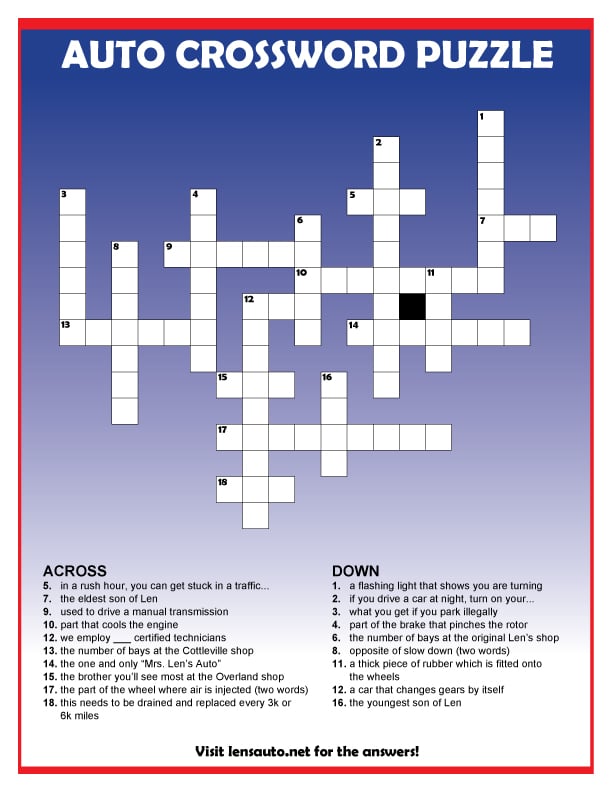
Fall 2022
A newsletter brought ot you from Len’s Auto Repair.
Are Your Tires Ready for Winter?
According to most states’ laws, tires are legally worn out when they have worn down to 2/32” of remaining tread depth. To help warn drivers that their tires have reached that point, tires sold in North America are required to have indicators molded into their tread design called “wear bars” which run across their tread pattern from their outside shoulder to inside shoulder. Wear bars are designed to visually connect the elements of the tire’s tread pattern and warn drivers when their tires no longer meet minimum tread depth requirements.
However, as a tire wears, it’s important to realize that the tire’s ability to perform in rain and snow will be reduced. With 2/32” of remaining tread depth, resistance to hydroplaning in the rain at highway speeds has been significantly reduced, and traction in snow has been virtually eliminated. If rain and wet roads are a concern, you should consider replacing your tires when they reach approximately 4/32” of remaining tread depth. Since water can’t be compressed, you need enough tread depth to allow rain to escape through the tire’s grooves. If the water can’t escape fast enough, your vehicle’s tires will be forced to hydroplane (float) on top of the water, losing traction.
If snow covered roads are a concern, you should consider replacing your tires when they reach approximately 6/32” of remaining tread depth to maintain good mobility. You need more tread depth in snow because your tires need to compress the snow in their grooves and release it as they roll.
Place a penny into several tread grooves across the tire. If part of Lincoln’s head is always covered by the tread, you have more than 2/32” of tread depth remaining. If Lincoln’s head isn’t disappearing, it is time to call Len’s to set up a time for tire replacement.

Winter Weather Tips
As the winter is upon us, here are some tips which can help you prepare for the changes in the weather that can surprise any of us. Taking some basic actions to be prepared will make it easier for you to be ready for whatever Mother Nature throws at us.
When using your heating system, there are some tips to help keep you warm and your windows clear. When using your defroster, make sure you are using the fresh air from outside of the car. Have you ever seen someone driving down the road and all of the windows are fogged up? The reason is the car is using the inside air and the system can’t get rid of the moisture in the air. Using the air conditioning in this mode helps too, since one of the things the A/C system does is remove the moisture from the air, and with the heat on you will keep the inside of the car warm. In fact, most newer cars will automatically turn on the A/C and use fresh air in defrost mode. If you don’t know about your vehicle, look in your owner’s manual, or drop by and we will be glad to show you how it works.
Your wipers are also key to keeping your windows clean. Making sure you have the proper washer fluid for cold weather will also help you do this. Having a snow brush in the car with an ice scraper will help keep you prepared for whatever happens.
Keeping your tires inflated properly and making sure you have good tread will help you with traction and control. Anti-lock brakes and traction control systems work much better when you have good tires with the most grip possible.
Hey Len’s, Why Do I Have to Pay for a Diagnostic Fee?
Your check engine light came on the other day on your automobile. Seems to be driving ok, but you call us to set up an appointment to have the problem diagnosed. During your conversation with the service advisor, you are informed that there will be a diagnostic charge associated with this check out. Why you ask? You just want to know why the check engine light is on. Let’s explain the difference in what you think you are calling for, and what we know we will have to do to diagnose it.
Len’s can plug in a scan tool like the auto parts store and pull a code logged in the computer. Let’s say it is a misfire code P0300 that is retrieved from the computers memory. You think, a misfire code, I haven’t felt a misfire while driving. This surely should be an easy thing to take care of. The auto parts store will give you a list of possible causes like a spark plug or a fuel injector. They may even recommend a repair. This is not a diagnostic, it is a guess, and that is why they do not charge you to pull the code. Len’s will not charge you to pull the code either. However, that is where the similarities end between us and an auto parts store.
Off the top of my head, I can think of the following things that can set a misfire code: a faulty oxygen sensor, a faulty mass air flow sensor, a failed fuel pump, a burned exhaust valve, blocked-up exhaust, bad gas, a slipped timing chain, shorted wiring, open wiring, or a worn camshaft. That is 10 things I just listed that could be the cause of a random misfire. NOTICE: no where in that list does it say spark plug, ignition coil, or fuel injector. While these things can cause a misfire when faulty, the actual potential cause of the misfire is extensive.
This is where the diagnostic charge comes in. We will perform testing on all relevant components to isolate the actual cause of the misfire. We start by identifying when the misfire happens, cold or hot, at idle or at cruise, under heavy load or light acceleration. We then diagnose which cylinder in the vehicle is actually having a misfire. Todays cars usually have either a 4, 6, or an 8 cylinder engine. Once we have isolated the cylinder, we begin to zone in on the actual cause. We may measure injector flow rates, primary and secondary ignition patterns, or perform a mechanical compression check on the cylinders. The technician’s experience comes into play here. They choose which tests to perform first, based on their experience diagnosing similar misfires on other vehicles.
In some cases, you may also be asked to pay for a diagnostic for things like isolating a noise from a suspension component. We charge this diagnostic when we are unable to isolate a noise by performing a visual inspection and a test drive. In these cases, we actually hook up diagnostic equipment onto the vehicle around the suspected area of the noise. We then test drive the vehicle listening through the diagnostic equipment to pinpoint which suspension component is making the noise.
In the end, performing the diagnostic in this way will lead to a logical positive testing result. A logical positive testing result is what you are paying for when you authorize a diagnostic, you are not a paying for a guess.
We authorize these diagnostics BEFORE we perform them, so you always have the option to opt out of the diagnostic if one is needed.
Len’s Auto Repair Crossword Puzzle

Garlic Toast Pizzas
A warm toasted pizza is irresistible on a chilly night. Top it off with pepperoni and mozzarella cheese for a simple yet delectable snack! This recipe is quick, and make eight slices in 15 minutes!
1 package frozen garlic Texas Toast
1/2 cup pizza sauce
1 package sliced Pepperoni
2 cups shredded Mozzarella Cheese
Preheat oven to 425 degrees. Place Texas Toast in a 15x10x1 inch baking pan. Bake for 5 minutes.
Now, spread toast with pizza sauce and top with pepperoni and cheese. Bake until cheese is melted, usually 4-5 minutes longer. ENJOY!


